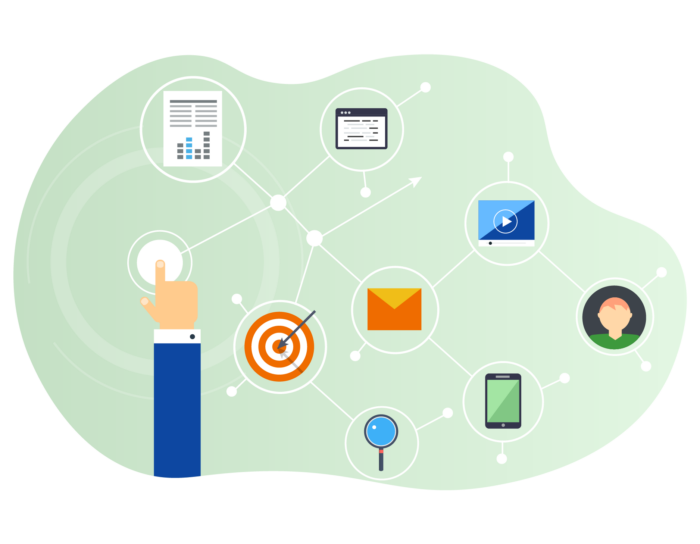Key Takeaways
- B2B marketing focuses on promoting products or services between companies, building relationships, and meeting specific business needs.
- Digital connections and quality content are essential as B2B audiences increasingly value useful materials and thought leadership.
- Key marketing channels include social media, email, events, video, and content marketing.
- Tracking KPIs like lead generation, conversion rates, and retention is crucial, with digital tools enhancing the efficiency and insights of this process.
What is B2B Marketing?
B2B marketing is the practice of promoting and selling products or services from one business to another, focusing on building relationships, understanding the specific needs of business clients, and providing solutions that enhance their operations or profitability.
B2B marketing involves communicating one company’s products or services (including software as a service) to other businesses and organizations. B2B is marketing between companies, as opposed to marketing by one company to the public at large.
B2B vs B2C marketing
B2B (business-to-business) and B2C (business-to-consumer) marketing differ in buyer motivation, messaging, and relationship dynamics. B2C buyers are driven by emotion and make faster, often impulse purchases influenced by brand image and advertising. B2B buyers, however, are motivated by ROI and value, making decisions that align with their organization’s goals.
The length of the buyer journey also varies. B2C purchases are generally quick, with consumers needing minimal information. B2B sales cycles are longer, involving multiple decision-makers and a more complex evaluation process. This makes patience and targeted messaging crucial for B2B marketers.
Messaging tone and style also differ. B2B communication is detailed and expertise-driven, designed for an informed audience with specific needs. B2C messaging is simplified, direct, and focused on creating a strong, immediate appeal for quick decisions.
Lastly, relationship-building is essential in B2B marketing, where trust and credibility with decision-makers lead to long-term contracts. B2C marketers focus on brand appeal to reach individual consumers rather than building ongoing relationships with each buyer.
For more on the differences between B2B and B2C marketing, check out our blog.
B2B marketing trends
Digital connections have been increasingly important for B2B marketers for years.
- Content marketing remains a big part of digital attention seeking, but increasingly savvy B2B audiences will demand higher quality, demonstrably useful material, Cummins says. “Your expertise has to be more helpful rather than self-interested.”
- Thought leadership: Marketers in the coming years will benefit from a shift in branding away from the company toward the individuals who work there, says Alex Panagis, founder of ScaleMath. “In previous years, businesses would choose to work with a specific company because of the name value in the industry,” Panagis says. “That is not really the case anymore. Businesses buy into people they like and believe share the same common values as them.”
- Personalized messaging: Not big data, could be what makes the difference between gaining a lead and driving one away. “In previous years, everyone has been too focused on automating their marketing, sending templated and canned emails to get maximum results with the minimum investment,” says Adam Hempenstall, CEO and founder of Better Proposals. “It’s not working anymore, and B2B audiences crave personalization. Take your time, craft personalized marketing messages, and you will see your open rates and response rates increase significantly.”
The most effective B2B marketing channels
It doesn’t matter how great your message is if you don’t place it where your customers will engage with it.
Here are some of the most powerful B2B marketing channels that will build and replenish your sales funnel for a continuous supply of leads, no matter how challenging the business environment.
Social media marketing
Facebook, Instagram, Twitter, LinkedIn, even Reddit, are all powerful platforms for B2B marketers to connect with audiences. Facebook is famous for its low-cost, broad-reach PPC platform. Paid social ads on LinkedIn cost more but typically bring in better B2B leads. (Learn more about the difference between Facebook and LinkedIn for B2B PPC advertising on our blog.)
Social media is much more than just the place for PPC ads, says Ambreen Sharif, cofounder and digital marketing consultant at Workplay Digital. Organic shared media dovetails well with other channels, both online and offline.
Email marketing
“You face a difficult task, to go from unwelcome spam to welcome business conversation,” says Cummins. “That is a tough, tough transition.”
Instead, he says, permission-based email outreach may soon generate more value as the world embraces the EU’s General Data Protection Regulation (GDPR), which requires marketers to allow recipients to opt out of email campaigns.
“Email is still essentially the hub of how business works,” Cummins says. “It’s critical.” Just be sure to ask for permission to stay on the right side of your audience. One easy way to begin these customer-driven email relationships is to post an email list form on your website so that visitors can subscribe to your newsletters or updates.
Video marketing
Most internet users watch video online, but that doesn’t mean B2B customers have stopped reading.
“Choose a topic that you’re an expert in and that would be of interest to your audience,” she says. “Create a short, high-quality video explaining the concept in simple terms. It’s valuable, it’s shareable, and it demonstrates your expertise in a creative way.”
Event marketing
“It’s not enough to just show up, hand out some business cards and hope for the best,” she says. “It’s worth the extra investment to have a speaking opportunity to demonstrate your expertise and showcase an all-star on your team who’s not only an expert but an engaging and personable speaker.”
Event marketing isn’t an entirely offline strategy. Enhance your booth or presentation by using mobile devices to access on- or offline mobile data-collection forms that let you collect lead information anywhere on the exhibition floor.
Content marketing
Nearly 90 percent of B2B purchasers perform online research when looking for a new product or service. This makes an inbound marketing strategy extremely valuable to B2B companies. Providing candid answers to your audience’s research questions is powerful. Never doubt that good content will surface at the top of their search results.
Engaging with savvy B2B audiences requires a content strategy focused on the reader. Cummins advises marketers to ask themselves two questions as they work on content: “What is the user looking for? And, are we providing that in a really helpful, engaging, intelligent way, human to human?” Successful inbound marketing content boils down to a single two-word goal, Cummins says: “Be helpful.”
Top B2B marketing KPIs
Key performance indicators, or KPIs, are the metrics that describe an organization’s progress toward its most important goals. KPIs range from broad data points, such as total yearly profit and sales by region, to very granular information, like contact volume by channel and new vs repeat site visits per month.
Every part of an enterprise has its own set of KPIs. Marketers use KPIs to track their successes and make necessary improvements — which is why we call them “key.”
Which KPIs are most important for marketers to track? That depends entirely on your goals. Here are 10 KPIs that no experienced marketer will ignore.
10 B2B marketing KPIs
- Site traffic. Most B2B websites serve multiple functions: They’re online sales hubs, industry resources, and communication points for customers. But no function is more important than generating leads. The more visitors you have, the more opportunities you have to convert those visitors into leads.
- Return on ad spend (ROAS). Did your last pay-per-click (PPC) campaign generate a profit? Did you target the right markets on your last billboard spend? Tracking ROAS is the only way to find out.
- Cost per lead (CPL). Every lead costs something. Tracking fluctuations in that cost over time can tell you a lot about inbound marketing and other lead-generation efforts. “That number should be coming down over time, if you’re doing a good job,” Cummins says. If it doesn’t, reconsider your strategy.
- Average revenue per customer (ARPC). Knowing the value of each customer makes it easier to allocate an effective marketing budget for both retention and drawing in new business.
- Conversion rates. Don’t just measure conversion rates in terms of sales but at each stage of the marketing funnel. “In content marketing, that’s going to be visitors to leads to some point in your sales process, down to becoming a customer,” Cummins says. “You need to have some sort of insight into conversion rates along those lines.”
- Click-through rate (CTR). This metric is crucial for measuring the effectiveness of PPC ad campaigns. The organic click-through rate measures how many visitors reach your site through search. This is an extremely important measure of the effectiveness of content marketing campaigns.
- Contact form conversions. Are your contact forms performing up to their full potential? Do you need to redesign them or place them somewhere else on your site? Find out by tracking the number of contact form impressions versus form completions.
- Customer churn. This is a ratio of the number of lost customers to the total number of customers at the beginning of the study period. A high churn rate indicates a problem. Either you’re not satisfying customers, or you need to invest in customer retention marketing strategies.
- Pipeline velocity. Measure how long it takes for a prospect to move through your B2B marketing funnel, from lead to customer. This figure tells you how effectively you’re nurturing leads. The B2B sales cycle is notoriously longer than B2C, but targeted marketing campaigns speed it up.
- Customer satisfaction. Wait a second, you might say. Isn’t this a customer service metric rather than a marketing KPI? Not necessarily. Customer satisfaction is the main goal of any successful business. Dissatisfied customers are an indication that your marketing materials are overpromising or misrepresenting your offerings.
Now that you have a few B2B marketing metrics to track, you’ll need tools to make sense of all those numbers. There are plenty of SaaS options, and even many free online tools, that provide KPI tracking and analytics for B2B marketers.
B2B marketing analytics tools
Your KPI numbers are just raw data. Turning that data into usable intelligence requires analytics tools. Every digital channel you use, from search engines to each individual social media account, generates its own data. Most of these services offer some degree of native analytics, but logging into every one of them every time makes it hard to write meaningful reports.
Marketers use analytics tools to organize the data from a wide variety of sources. Marketers and executives build custom dashboards — personalized analytics pages that display data visually — to gauge a campaign’s success against particular goals on a single screen.
Here are some of the leading marketing analytics tools on the market:
- Adobe Analytics. Adobe’s enterprise-level analytics software tracks both online and offline data, with advanced AI algorithms for predictive analysis. But this full-service analytics platform prices out many small and medium-sized businesses. One recent review estimated costs of between $30,000 and $350,000 per year.
- Google Analytics. The free version of Google Analytics is an essential tool for measuring site traffic, onsite behavior, pay-per-click effectiveness, and any number of conversion types. If a data point ties into your website, Google Analytics can probably track it. If you were starting a digital-only marketing analytics project from scratch, this would be a good place to start. The free version provides plenty of data, but a paid version — Google Analytics 360 — provides enterprise-level services on par with Adobe Analytics (with pricing reportedly around $150,000).
- HubSpot. HubSpot is an integrated growth platform that combines a free customer resource management tool with related software hubs for sales, customer service, and marketing. HubSpot’s analytics focus on inbound marketing KPIs to help marketers convert visitors into leads and leads into customers. Pricing depends on the number of leads you wish to track as well as access to advanced services. The Marketing Hub ranges from $50 per month to $3,200 per month at the time of this writing.
- SEMRush. Like its competitor, Moz, SEMRush provides marketing analytics specifically for search engine optimization (SEO). It’s built to track SEO-related KPIs like site traffic, CTR, and keyword rankings. Both SEMRush and Moz start at just $99 per month. While each platform has its partisans, the general opinion is that Moz is easier to use for beginners, while SEMRush is more powerful for experienced digital marketers.
Analytics platforms segment your data, but not all of them automatically import data from all channels — especially if you go beyond digital marketing. Before choosing an analytics platform, consider which channels your audience engages with. Let’s look at the leading marketing channels B2B marketers use to draw in new leads and turn them into customers.













Send Comment:
1 Comments:
More than a year ago
Thanks for the detailed article. It helped me verify most of my ideas about B2B marketing. I've been a firm believer that traditional marketing strategies don't work to their fullest in B2B. Thankfully, even before the pandemic we started to focus more on digital channels. The likelihood of a LinkedIN post to bring in a lead is way higher than a billboard that the average person wouldn't understand. I agree that personalized messages are better for B2B audiences, but you also need to keep in mind scalability. If you can't scale your marketing/sales operations, it doesn't matter if you get a few high-quality leads.